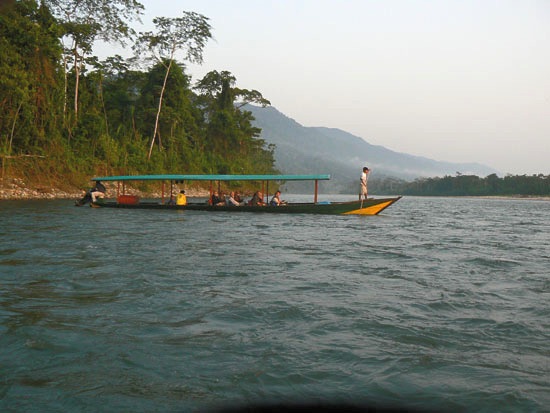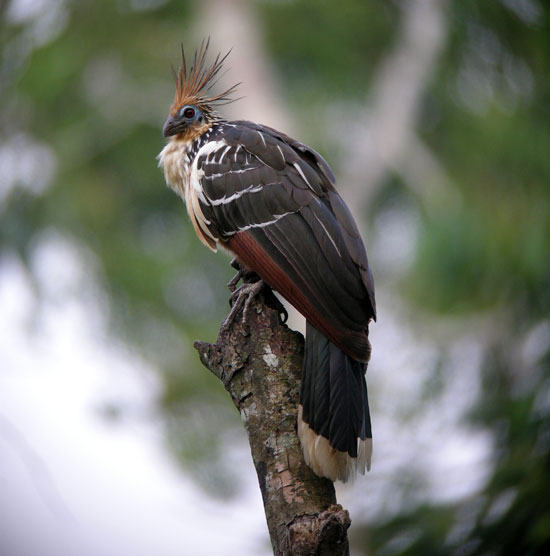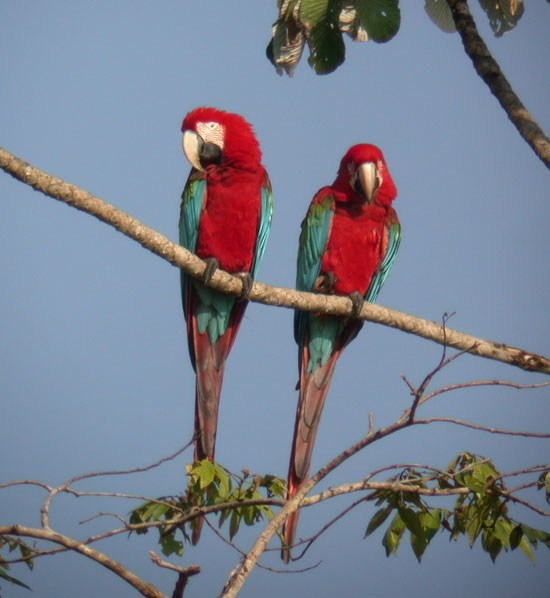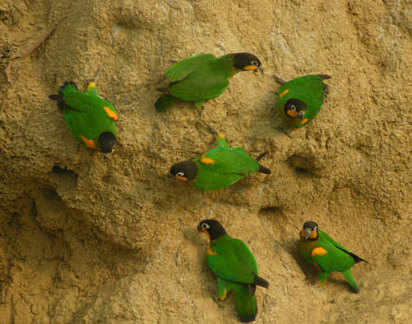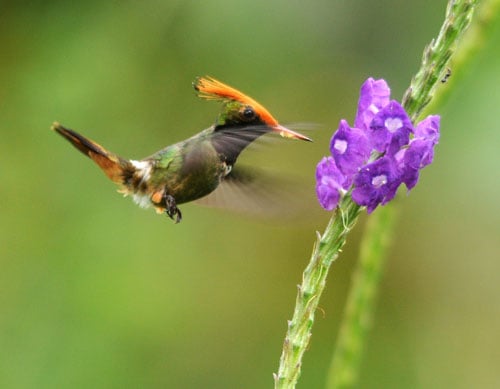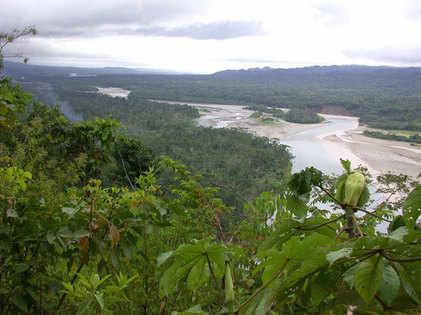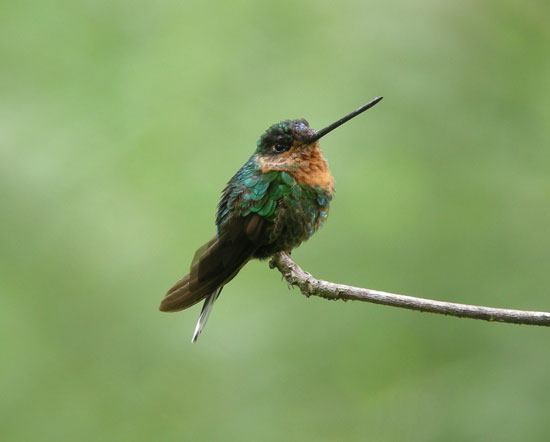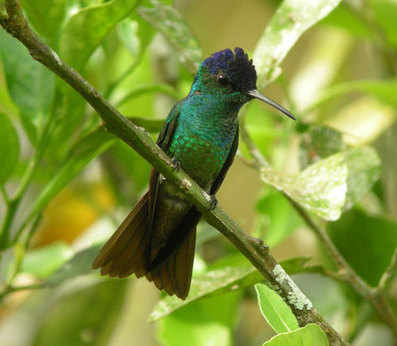PERU - ANDES TO AMAZON & BEYOND! ** PAGE UNDER CONSTRUCTION **
Day 1 Arrival in Lima - 6th September
Arrival in Lima and transfer to a nearby hotel for the night. Night in Lima.
Day 2 Lima - Pucusana - Pantanos de Villa - fly to Cusco
We will begin our coverage of this amazing country by heading south of Lima and visit the marshes and lowland scrub at the northernmost tip of the Atacama Desert, which should provide a gentle introduction to the Peruvian avifauna such as Great and White-tufted Grebes, Andean Coot, White-cheeked Pintail, Plumbeous Rail, Peruvian Thick-knee, West Peruvian Dove, Croaking Ground-dove, Long-tailed Mockingbird, Amazilia Hummingbird, the endemic Coastal Miner, Many-coloured Rush-tyrant, Wren-like Rushbird, Drab and Chestnut-throated Seedeaters, Blue-black Grassquit, Collared Warbling-finch, Hooded Siskin, Cinereous Conebill and Pied-crested Tit-tyrant. Probably the highlight will be our boat ride around the picturesque harbour and nearby sea cliffs of Pucusana in search of the endemic Surf Cinclodes. This is also a great place for close views of the stunning Inca Tern, Humboldt Penguin, Red-legged and Guanay Cormorants, Peruvian Pelican, Peruvian and usually a few Blue-footed Boobies plus a good variety of other seabirds are sometimes present close to shore. Gulls are well represented with Kelp, Belcher’s and the beautiful Grey, and other species here include American and Blackish Oystercatchers and Snowy Plover. In the late afternoon we will take the short flight across the mighty snow-capped peaks of the Andes to Cusco, the 3400m gateway to Amazonia and some of the best birding on the planet. Night in Cusco.
Day 3 Huacarpay Lakes - Ollantaytambo
This morning we will visit the bird-rich Huacarpay Lake and surrounding arid hillsides just outside of town. This is an amazing place to bird, where the lake is home to many high Andean water birds including Puna Ibis, Plumbeous Rail, Andean Lapwing, White-backed Stilt, Speckled and Puna Teals, Andean Duck, Yellow-billed Pintail and Andean Gull. Amongst a variety of hummingbirds present, we will search out the rare and local endemic Bearded Mountaineer which is only found in a few arid valleys. We will watch for the local Bare-faced and Black-winged Ground-Doves along the cactus hillsides and other specialities include Streak-fronted Thornbird, the endemic Rusty-fronted Canastero, Wren-like Rushbird, Andean Negrito, Spot-billed and Rufous-naped Ground-Tyrants, Many-coloured Rush-Tyrant, Brown-bellied Swallow, Sparkling Violetear, Green-tailed Trainbearer, Giant Hummingbird, Blue-and-yellow Tanager, Greenish Yellow-Finch, Band-tailed Seedeater, Ash-breasted, Mourning, and Peruvian Sierra-Finches and Yellow-winged Blackbird. We will spend the first of 2 nights in Ollantaytambo.
Day 4 Machu Picchu
We begin this morning with a trainride for the downriver journey to Aguas Calientes at the base of the famed ruins of Machu Picchu. The tracks follow alongside the Urubamba River, so watch for the splendid Torrent Duck and White-capped Dipper en-route. Once at Aguas Calientes we will board a comfortable bus for the twenty-minute ride up hairpin switchbacks to Machu Picchu, where we will have ample time to learn about this “Lost City of the Incas”, admiring its unique architecture and the dramatic scenery. And of course there are numerous photographic opportunities! Not only is Machu Picchu a must-visit site at least once in your life it is also a fantastic place to see a good variety of interesting and specialized birds. While at the ruins keep an eye out for the endemic Inca Wren as well as White-winged Black-Tyrant, which likes to hunt along the forest edge, and the local White-throated Hawk can sometimes be seen soaring overhead. We even saw the might Andean Condor here on our last visit. Below the ruins lies good forest where we will look for Mitred Parakeet, Chestnut-breasted Coronet, White-bellied Woodstar, the endemic Green-and-white Hummingbird, Ocellated Piculet, Andean Cock-of-the-Rock, Sclater’s Tyrannulet, the local Pale-legged and Russet-crowned Warblers, a host of tanagers including Rust-and-yellow and Silver-backed, Chestnut-capped Brush-finch and Dusky-Green Oropendola to name a few. We then backtrack by train upriver to Ollantaytambo, and our lovely hotel this evening. Overnight in Ollantaytambo.
Day 5 Abra Malaga
As dawn breaks across a landscape of rugged snow capped peaks we will find ourselves on the way to Abra Malaga this morning. After crossing the 4,230 m pass our descent will take quite a while and the lower we go the more the vegetation increases and we find ourselves in a world of lichen-covered elfin forest. A profusion of birds awaits in this beautiful temperate forest where we will look for the local White-rumped Hawk, Mitred Parakeet, the extraordinary Sword-billed Hummingbird, Coppery-naped Puffleg, Marcapata Spinetail, Pale-footed Swallow, Inca and Mountain Wrens, Barred Fruiteater, Unstreaked Tit-Tyrant, Three-striped, the local Parodi’s, Oleaginous, Black-capped and Superciliared Hemispinguses, Golden-collared Tanager, several species of mountain-tanagers, White-browed Conebill, Cusco Brush-finch and Plush-capped Finch! Moving higher up we will search for Andean Condor, Rufous Antpitta which skulks in the shadows, Violet-throated Starfrontlet, Rufous-breasted Chat-tyrant, Red-crested Cotinga, Puna Thistletail, Trilling Tapaculo, Tit-like Dacnis, White-browed Conebill and Rusty Flowerpiercer. Higher up still we will reach the puna zone with its grassland and small lakes where we may see Andean Goose, Andean Ibis, Andean Condor, Mountain Caracara, Aplomado Falcon, Grey-breasted Seed-Snipe, Andean Hillstar, Blue-mantled Thornbill, Puna and Ochre-naped Ground-Tyrants, the very local Line-fronted Canastero, Paramo Pipit, White-winged Diuca-Finch and Bright-rumped Yellow-Finch. Weather permitting we will search in the Polylepis forest for three highly prized species: Royal Cinclodes, White-browed Tit-Spinetail and Ash-breasted Tit-Tyrant. Other possibilities in this forest include Tawny Tit-Spinetail, Puna Tapaculo, Red-rumped Bush-Tyrant and D’Orbigny’s Chat-tyrant. Late in the afternoon we will make one final stop to find the endemic White-tufted Sunbeam, and as always there will be other birds to see such as Shining Sunbeam, Giant Hummingbird, Andean Flicker, Creamy-crested Spinetail, Stripe-headed Antpitta, Tufted Tit-Tyrant and Plain-capped Ground-Tyrant among many others. Our comfortable hotel will be a welcome sight after a long but rewarding day of birding in the High Andes of Peru. Night in Ollantaytambo..
Day 6 Ollantaytambo - Wayquechas Cloud Forest Biological Station
This morning we will head towards the fabled Manu Road, finding plenty of new birds along the way as we cross dry valleys interspersed with Puna grassland. Searching this seemingly barren area we will look for Andean Tinamou, Mountain Caracara, Variable Hawk, Spot-winged Pigeon, Creamy-crested Spinetail, Hooded Siskin, Cinereous Conebill and the smart endemic Chestnut-breasted Mountain-Finch. On one tour we also found a flock of Tawny-throated Dotterels as well. Once over Acjanaco Pass and onto the eastern slope of the Andes we enter elfin forest, humid montane forest and chusquea bamboo where the birdlife inevitably changes and should include White-collared Jay, Grey-breasted Mountain-Toucan, Crimson-mantled Woodpecker, Barred Fruiteater, Sierran Elaenia, Red-crested Cotinga, Moustached Flowerpiercer, Hooded, Scarlet-bellied and Chestnut-bellied Mountain-Tanagers, Golden-collared Tanager and Mountain Cacique. We will inevitably encounter numerous mixed-species feeding flocks throughout our time on the Manu Road, and as we try and keep up with the action and the kaleidoscope of colours and movement we can see Tyrian Metaltail, Amethyst-throated Sunangel, Ochraceous-breasted Flycatcher, White-throated and White-banded Tyrannulets, Pearled Treerunner, Rufous-breasted Chat-tyrant, Drab Hemispingus, and Blue-black, Gold-naped, Blue-capped and Grass-green Tanagers and Grey-eared Brush-Finch. As the road drops in elevation quickly we will make a special effort to find the beautiful endemic Red-and-White Antpitta, whilst chances of finding Rusty-breasted Antpitta are a lot less! And we need to keep an eye on the roadside trees for Andean Guan, Speckle-faced and Scaly-naped Parrots, Highland Motmot and Golden-headed Quetzal. We will spend tonight at Wayquechas Biological Station.
Day 7 Manu Road - Cock-of-the-Rock Lodge
Maybe the first bird of the day will be a Swallow-tailed Nightjar as we explore the surroundings of the lodge before first light. There's a fantastic selection of species to be found up here in the cloud forest and other possible species include Hooded Tinamou, Andean Guan, Stripe-faced Wood-Quail, Solitary Eagle, Grey-breasted Mountain-Toucan, Channel-billed Toucan, Blue-banded & Southern Emerald Toucanet, Yungas Pygmy-Owl, Scaly-naped Parrot, Crimson-mantled Woodpecker, Reddish Hermit, Lesser Violetear, Amethyst-throated Sunangel, Fawn-breasted Brilliant, Violet-throated Starfrontlet, Sword-billed Hummingbird, Rufous-capped Thornbill, Long-tailed Sylph, Chestnut-breasted Coronet, Buff-thighed Puffleg, Scaled & Tyrian Metaltail, White-bellied & Amethyst Woodstar, Golden-headed Quetzal, Band-tailed & Barred Fruiteater, Andean Cock-of-the-Rock, Andean Solitaire, Urubamba Antpitta, Azara's Spinetail, Montane Woodcreeper, Puna Thistletail, Ornate & Streak-necked Flycatchers, Tawny-rumped, Ashy-headed, White-throated & White-banded Tyrannulets, Sierran Elaenia, Golden-browed & Rufous-breasted Chat-Tyrants, Trilling Tapaculo, Black-throated Tody-Tyrant, Andean Swallow, Chiguanco & Glossy-black Thrush, Citrine, Three-striped & Pale-legged Warbler, Spectacled Redstart, Fulvous Wren, White-collared Jay, Chestnut-capped & Black-faced Brushfinches, Drab & Superciliaried Hemispingus, Common Chlorospingus, Dusky-green Oropendola, Mountain & Yellow-rumped Cacique, Hooded & Scarlet-bellied Mountain-Tanagers, Golden-collared, Blue-capped, Fawn-breasted, Rust-and-yellow, Blue-and-black & Grass-green Tanagers, Masked, Black-throated & Moustached Flowerpiercers, Black-backed Grosbeak and Plain-coloured Seedeater,
Later this morning we will drive down the Manu Road towards our next lodge situated in lower montane evergreen forest beside crystal clear streams - the famous Cock-of-the-Rock Lodge. However, it could well take us all day to get there depending on how awesome the bird activity is! Other possibilities today could include Buff-thighed Puffleg, Blue-banded Toucanet, Crimson-mantled Woodpecker, White-eared Solitaire, Maroon-belted Chat-Tyrant, Handsome Flycatcher, Fulvous Wren, Northern White-crowned Tapaculo, Dusky-green Oropendola, Yellow-whiskered Bush-Tanager, and a whole assortment of tanagers including Slaty, Golden-collared and Orange-eared amongst an incredibly long list of other possibilities. Night at Cock-of-the-Rock Lodge.
Days 8 - 9 Manu Road - Cock-of-the-Rock Lodge
We will have three full days to bird the Manu Road both above and below our lodge and this represents an altitude range of 7,000 ft to 2,000 ft, and the range in bird diversification is even more impressive. There is very good birding right around the lodge itself with banana feeders that attract Highland Motmot, the glorious Versicoloured Barbet, Golden, Saffron-crowned and Paradise Tanagers and Orange-bellied Euphonia. The hummer feeders and flowerbeds here attract Rufous Booted Racket-tail, Violet-fronted Brilliant, Green Hermit, Lesser Violetear, Wire-crested Thorntail, White-bellied Woodstar, and Wedge-billed, Many-spotted and Speckled Hummingbirds. Other garden birds include Stripe-chested Antwren, Two-banded Warbler, Orange-bellied Euphonia, Beryl-spangled, Blue-necked and Spotted Tanagers and Black-faced Brush-finch, whilst mammals such as Tayra and Agouti are also present. A nearby hide overlooks an Andean Cock-of-the-Rock lek where one can sit and watch males of this splendid bird display at very close range. Trails near the lodge can produce such stars as Brown Tinamou, Rufous-breasted Antthrush, Yellow-breasted and Yellow-rumped Antwrens, Slaty Gnateater, Inca Flycatcher, Yungas and Cerulean-capped Manakins, Golden-eyed Flowerpiercer, and Spotted Nightingale-Thrush. Along the road just above the lodge watch for the charming Crested Quetzal, Bolivian Tyrannulet, Smoke-coloured Pewee, Black-streaked Puffbird, Red-billed Scythebill, Montane Woodcreeper, Grey-mantled Wren, Andean Solitaire, Inca Jay, Golden-eared, Orange-eared and Black-goggled Tanagers, Blue-naped Chlorophonia, Black-eared Hemispingus, Golden-collared Honeycreeper and Dusky-green Oropendola.
We will also explore higher up the road into a different life zone where we will look for stunners like Solitary Eagle, White-throated Hawk, Blue-banded Toucanet, Yungas Pygmy-Owl, Rufous-capped Thornbill, Greater Scythebill, Striped and Black-billed Treehunters, Montane Foliage-gleaner, White-capped Dipper, White-eared Solitaire, Glossy-black Thrush, Band-tailed Fruiteater, Three-striped and Russet-crowned Warblers, Deep-blue Flowerpiercer, tanagers galore, Yellow-throated Bush-tanager, and if we are lucky we may find a superb Chestnut-crested Cotinga, as we did on our last tour.
We will also spend time along the road below the lodge. Here we will watch for Sunbittern, Black-and-chestnut Eagle, Wattled Guan, Fine-barred Piculet, Crimson-crested Woodpecker, Bluish-fronted Jacamar, Amazonian Umbrellabird, White-backed Fire-eye, Cabanis’s Spinetail, Chestnut-backed Antshrike, Stripe-chested, Foothill, Yellow-breasted Warbling Antbird, Warbling and Ornate Antwrens, Mottle-backed Elaenia, Black-backed Tody-Tyrant, and Swallow Tanager to name a few. And we should at least hear Brown Tinamou and Rufous-breasted Wood-quail! On at least one evening we will visit a special site for Lyre-tailed Nightjar, and can also search for Andean Potoo, Rufescent Screech-owl and Rufous-banded Owl, which were all seen on our last tour. All of this takes place in a beautiful setting of forested valleys, rushing rivers, waterfalls, mild temperatures, good food and comfortable lodging. Nights at Cock-of-the-Rock Lodge.
Days 10 - 11 Manu Road - Manu Bio Lodge (formerly Villa Carmen Biological Station)
We will take most of the morning to travel and bird the Manu Road to the Manu Bio Lodge (formerly called Villa Carmen), where we will spend the next 2 nights. Stopping along the way we will look for the mythical Lanceolated Monklet, flowering trees with hummingbirds, Plum-throated Cotinga, Military Macaw, fruiting trees with elaenia and tanager flocks, and Epaulet Oriole just to name a few. Lower down we will make a stop for the rare and local Rusty-fronted Tody-Flycatcher, and will also look for Black Caracara, Golden-tailed Sapphire, Yellow-breasted Antwren, Manu Antbird, Russet, Uniform and Chestnut-backed Antshrikes, Chestnut-breasted Wren, Hazel-fronted Pygmy-tyrant, Variegated Bristle-Tyrant, Slender-footed and Cinnamon-faced Tyrannulets, Olive-backed Woodcreeper, Black-billed Treehunter, Ash-browed Spinetail, Buff-fronted Foliage-gleaner, Red-eyed Vireo, Slate-throated Whitestart, Golden-bellied (Cusco) Warbler, Tropical Parula and Olivaceous Siskin. Tanagers should be well represented with numerous possibilities as always, such as Black-goggled, Yellow-crested, Golden-naped, Spotted, Beryl-spangled and Bay-headed Tanagers all likely, whilst Blue-headed Macaw can sometimes be seen along the road once we are in sight of the river. In the tropical lowlands some wide open fields and cultivated areas are good for Chestnut-bellied Seed-finch, Bran-coloured Flycatcher and both Black-faced and Magpie Tanagers.
We will hopefully arrive at Manu Bio Lodge in time for some afternoon birding in the lush rainforest, which is swathed in large stands of bamboo that is home to special birds like Rufous-headed Woodpecker, Rufous-breasted Piculet, Striated Antbird, Bamboo Antshrike, Dusky-tailed Flatbill, and the stunning White-cheeked Tody-Flycatcher. We will also be on the lookout for Blue-headed Macaw if we still haven't seen it yet, Scarlet-hooded Barbet, Round-tailed and Fiery-capped Manakins, among many other species. Hummingbird and tanager feeders could give us great views of several stunning species, such as White-browed & Koepcke's Hermit, Buff-tailed Sicklebill, Grey-breasted Sabrewing, Rufous-webbed Brilliant, Blue-fronted Lancebill, Long-billed Starthroat, Gould's Jewelfront, Blue-tailed & Sapphire-spanged Emerald, Many-spotted Hummingbird, Golden-tailed & White-chinned Sapphire, White-necked Jacobin, Fork-tailed Woodnymph, Black-throated Mango, Rufous-crested Coquette, and even a few more!
Other species possible in this fantastic area include Undulated, Little, Bartlett's, Grey, Cinereous & Black-capped Tinamou, Spix's Guan, Brazilian Teal, Least Grebe, Hoatzin, Razor-billed Curassow, Pale-winged Trumpeter, Rufescent & Fasciated Tiger-Heron, Capped Heron, Limpkin, Grey-cowled Wood-Rail, Purple Gallinule, Blackish Rail, Rufous-sided & Uniform Crakes, Sungrebe, King & Greater Yellow-headed Vultures, Black-and-white & Ornate Hawk-Eagle, Bicoloured, Roadside & Great Black Hawk, Swallow-tailed Kite, Great & Common Potoo, Tropical & Tawny-bellied Screech-Owls, Striped & Black-banded Owl, Common Pauraque, Ladder-tailed Nightjar, Pheasant & Little Cuckoo, Blue-and-yellow Macaw, Yellow-crowned Parrot, Dusky-headed & White-eyed Parakeets, Red-bellied & Chestnut-fronted Macaws, Black & Red-throated Caracara, Buckley's & Collared Forest-Falcons, Bat Falcon, Geoffroy's Daggerbill, Buff-tailed Sicklebill, Pale-tailed Barbthroat, Chestnut-eared Aracari, Southern Emerald Toucanet, Rufous-breasted, Ocellated & Fine-barred Piculets, Spot-breasted, Red-stained, Cream-coloured, Crimson-crested, Lineated & Little Woodpeckers, Scarlet-hooded & Lemon-throated Barbets, Green, Ringed & Amazon Kingfishers, Blue-banded Toucanet, Black-tailed Trogon, Amazonian Motmot, Pale-vented Pigeon, Swallow-winged & Semi-collared Puffbirds, Rufous-capped Nunlet, Yellow-billed, White-fronted & Black-fronted Nunbirds, Plum-throated Cotinga, Chapman's, Pale-rumped, Short-tailed & Fork-tailed Palm Swift, Streaked Xenops, Olive-backed, Cinnamon-throated, Buff-throated & Straight-billed Woodcreepers, Red-billed Scythebill, Black-billed Treehunter, Plain Softtail, Buff-browed, Ruddy, Ochre-throated & Dusky-cheeked Foliage-Gleaners, Cabanis's & Plain-crowned Spinetail, Amazonian & Thrush-like Antpitta, Chestnut-backed, White-shouldered, Bamboo & Great Antshrikes, White-lined, Peruvian Warbling, Black-faced, Black-throated, Goeldi's, Yellow-breasted Warbling, Brownish-headed, Riparian & Manu Antbirds, Stripe-chested, Yellow-rumped, Yellow-breasted, Rusty-winged & Pygmy Antwrens, Plain Antvireo, White-eyed Stipplethroat, Western Fire-eye, Yellow & Torrent Tyrannulet, Short-crested, Sepia-capped, Euler's, Sulphur-bellied & Grey-capped Flycatchers, Smoke-coloured Pewee, Forest Elaenia, Dusky-tailed & Olive-faced Flatbills, Variegated Bristle-Tyrant, Long-tailed Tyrant, Spotted, Yellow-browed, White-cheeked & Black-backed Tody-Flycatchers, Flammulated Pygmy-Tyrant, Johannes's Tody-Tyrant, White-winged & White-banded Swallows, Ringed Antpipit, Pale-legged Hornero, Hauxwell's & Black-billed Thrushes, Thrush-like, Scaly-breasted, Musician & Moustached Wrens, Round-tailed & Band-tailed Manakins, Red-capped Cardinal, Buff-rumped Warbler, Bare-necked Fruitcrow, Orange-fronted Plushcrown, Russet-backed & Crested Oropendolas, Yellow-billed & Solitary Black Caciques, Pectoral Sparrow, Chestnut-bellied Seed-Finch, Chestnut-bellied, Black-and-white & Double-collared Seedeaters, Rufous-bellied, Golden-bellied & Thick-billed Euphonia, Chestnut-vented Conebill, Olivaceous Siskin, Yellow-bellied, Yellow-crested, Bay-headed, Scarlet, Opal-rumped & Blue-necked Tanagers, White-winged Shrike-Tanager, Green & Purple Honeycreepers, Yellow-bellied Dacnis, and Slate-coloured & Amazonian Grosbeaks. We will spend 2 nights at Manu Bio Lodge (formerly Villa Carmen).
Days 12 - 13 Villa Carmen - Boat ride into Manu Biosphere Reserve - Tambo Blanquillo
After a few more hours of birding at Manu Bio Lodge, we will drive to the end of the road and board a motorized canoe that will take us down the Madre de Dios River to the Manu - possibly one of the remotest locations you will ever visit on a birding tour! Expect a lot of birds along the journey such as Fasciated Tiger-Heron, the gorgeous Capped and Cocoi Herons, Slate-coloured Hawk, Bat Falcon, Collared Plover, the boldly patterned Pied Lapwing, Horned Screamer, Large-billed and Yellow-billed Terns, Blue-and-yellow, Scarlet, Red-and-green, Chestnut-fronted and Red-bellied Macaws, Blue-throated Piping-Guan, the tern-like Sand-coloured Nighthawk, Ladder-tailed Nightjar, Ringed and Amazon Kingfishers, Bare-necked Fruitcrow, Drab Water-Tyrant, White-banded Swallow and Red-capped Cardinal. As we get further into Amazonia more and more macaws and parrots will appear and there is nothing as exhilarating as sailing along the river with flocks of Blue-and-yellow Macaws screeching overhead. This being our introduction into Manu will surely be a memorable day for us all!
We’ll have two full days in this amazing area. Diversity is spectacular, and we’ll bird trails, towers, and oxbow lakes. Large stands of bamboo hold many local and sought-after species, and the extensive terra firme and transitional floodplain forest hold a mind-boggling variety of bird-life. A canopy observation tower gives us a chance to see the canopy birds at close range, including many species of toucans, aracaris, tanagers, euphonias, woodpeckers, parrots, oropendolas, and others. Some of the more interesting species we will be searching for in the bamboo include Manu Antbird, White-cheeked Tody-Flycatcher and Peruvian Recurvebill. We also look for the near-endemic Rufous-fronted Antthrush, Razor-billed Curassow, Pale-winged Trumpeter, Pavonine Quetzal, Purus Jacamar, Western Striolated-Puffbird and Rufous-capped Nunlet to name but a few. Great mammal sightings are also possible including various species of monkey, Giant Otters, tapirs, peccaries and on very rare occasions even a Jaguar.
During our time here, we’ll have several activities such as a boat ride on an oxbow lake, a visit to a parrot clay lick, and a visit to the canopy platform. An early morning visit to the clay lick should yield numbers of Yellow-crowned, Orange-cheeked and Blue-headed Parrots, Chestnut-fronted Macaw, and most mornings groups of Red-and-green Macaws come down, though every day is different and unpredictable. Late morning will see us on the canopy platform where one has a totally novel view of the tropical rainforest. Here we’ll have a better chance to see species such as Gilded Barbet, Amazonian Pygmy-Owl, Purple-throated Fruitcrow, White-necked Puffbird, and Paradise, Turquoise and Green-and-gold Tanagers. Finally, in the afternoon, we’ll take a two-hour boat ride on the lake, where we’ll look for Hoatzin, Sungrebe, Horned Screamer, American Pygmy and Green-and-rufous Kingfishers and Pale-eyed Blackbird. With luck, we may see the rare Agami Heron and possibly spot a rail or two while looking for the local family of Giant Otters.
We will be staying at Tambo Blanquillo Lodge, which offers an extraordinary nature retreat. Spanning 400 hectares in the Manu National Park buffer zone, our lodge features three lagoons, a captivating macaw claylick, mammal claylicks, and a panoramic canopy tower.
There's also a mammal clay lick at Tambo Blanquillo, located a short distance away from the lodge, where different mammal species such as Tapirs, Capibaras, Agoutis, Peccaries and even different species of monkeys congregate to ingest -similarly to the Macaws- salts and minerals to balance their pHs and their diets. We will visit this place late in the afternoon, and sit in custom hide as the night arrives, waiting for these species to visit the area. It is also not uncommon to see other species in this area, such as Jaguars or Ocelots as they look for their next meal. We shall spend the next 2 nights at Tambo Blanquillo in the Manu.
Day 14 - 16 Los Amigos Biological Station
Located five hours by road and river northwest of Puerto Maldonado, the Los Amigos Biological Station is where the Los Amigos and Madre de Dios Rivers converge. Adjacent to the Los Amigos Conservation Concession, with world-famous Manu National Park to the west, Los Amigos is part of a watershed that includes millions of acres of protected wilderness in southeastern Peru. The landscape is a mosaic of terrestrial and aquatic habitats, including palm swamps, bamboo thickets, oxbow lakes, and various types of flooded and non-flooded forests. Wildlife is abundant, including 12 globally threatened species and abundant Amazonian fauna including Giant Otters, Spider Monkeys and Jaguars, with over 550 birds on the bird list. Get ready for some serious birding, with species such as Pavonine Quetzal, Rufous-fronted Antthrush, and Pale-winged Trumpeter. Impressively, 308 birds were logged around the grounds on the 2015 Global Big Day and Sean Williams set a new record for most birds observed in a single day without a motorized vehicle here on July 23rd, 2015 with 345 species in 19 hours over 11 miles! Other birds to look for include Purus Jacamar, Manu Antbird, Harpy Eagle, and Musician Wren. Upon arrival we will no doubt be excited to explore the immediate vicinity as it's not out of the ordinary to see Undulated Tinamou feeding on the lawn!
Some of the more interesting and unusual species possible in the bamboo are Rufous-headed Woodpecker, Manu Antbird, Peruvian Recurvebill and Long-crested Pygmy-Tyrant. Throughout the forest various species of foliage-gleaners and antbirds join in mixed flocks. Some of the scarcer species here include Bartlett’s Tinamou, Razor-billed Curassow, Pale-winged Trumpeter, Pavonine Quetzal, Purus Jacamar, Cream-colored Woodpecker, Banded Antbird, Royal Flycatcher and Musician Wren to name but a few. Megas here include Rufous-fronted Antthrush, Black-faced Cotinga, Long-crested Pygmy-Tyrant and Peruvian Recurvebill. And it's a great place for mammals and other wildlife too with possibilities of seeing Emperor Tamarin near the lodge, as well as Jaguar and Tapir on the trails!
We are in for a great time here. Rio Los Amigos Research Station is a vey modern set-up in the rain forest with good trails, electric light and even internet!
Other ossible species here include Variegated & Great Tinamou, Speckled Chachalaca, Horned Screamer, Starred Wood-Quail, Spix's Guan, Blue-throated Piping-Guan, Hoatzin, Ocellated Poorwill, Ruddy Quail-Dove, Grey-fronted Dove, White-bearded, Reddish & Rufous-breasted Hermits, Gould's Jewelfront, White-chinned Sapphire, Grey-breasted & Chestnut-headed Crakes, Pale-winged Trumpeter, King Vulture, Black Hawk-Eagle, Ornate Hawk-Eagle, White-browed Hawk, Double-toothed & Plumbeous Kites, Large-billed Tern, Jabiru, Wood Stork, Crested Owl, Tawny-bellied Screech-Owl, Amazonian Pygmy Owl, Curl-crested Aracari, Green-backed, Black-tailed & Blue-crowned Trogons, Amazonian & Rufous Motmots, Brown-banded, Semi-collared, Chestnut-capped & Western Striolated Puffbirds, Fulvous-chinned Nunlet, White-fronted & Yellow-billed Nunbirds, White-throated & Bluish-fronted Jacamars, Little, Yellow-tufted, Crimson-crested & Red-necked Woodpeckers, Blue-headed & White-bellied Parrots, Cobalt-winged Parakeet, Scarlet & Red-and-green Macaws, Fasciated, Dusky-throated, Bluish-slate, Spot-winged, Plain-winged & Bamboo Antshrikes, Rio Madeira Stipplethroat, Amazonian-Streaked, Dot-winged & White-flanked Antwrens, Band-tailed, Black, Grey, White-browed, Silvered, Plumbeous, Black-faced & Chestnut-tailed Antbirds, Black-spotted Bare-eye, Black-faced Antthrush, Ash-throated Gnateater, Point-tailed Palmcreeper, Ruddy Spinetail, White-chinned, Wedge-billed & Inambari Woodcreepers, Ochre-throated, Olive-backed & Rufous-rumped Foliage-Gleaners, Chestnut-winged Hookbill, Dwarf Tyrant-Manakin, Fiery-capped Manakin, Screaming Piha, Purple-throated Fruitcrow, Black-tailed Tityra, Pink-throated Becard, Cinereous Mourner, Wing-barred Piprites, Long-crested & Flammulated Pygmy-Tyrants, White-bellied Tody-Tyrant, Sulphury & Bran-coloured Flycatchers, Forest Elaenia, Large-headed & Rufous-tailed Flatbills, White-banded Swallow, Scaly-breasted & Buff-breasted Wrens, Slaty-capped Shrike-Vireo, Casqued & Yellow-rumped Caciques, Olive Oropendola, Violaceous Jay, Red-crowned Ant-Tanager, Amazonian Grosbeak, Magpie, Flame-crested, Masked Crimson, Blue-necked, Palm, Silver-beaked, Masked, Turquoise, Paradise, Green-and-gold & Swallow Tanagers and both Black-faced & Blue Dacnis.
Day 17 Los Amigos - Puerto Maldonado - Lima - End of Tour - 22nd September
This morning we will travel to Laberinto by boat and from there drive to the airport in Puerto Maldonado for our flight to Lima where the tour concludes this evening.
PLEASE ASK ABOUT OUR PRE-TOUR EXTENSION: Visiting Lomas de Lachay, Santa Eulalia, Marcapomacocha and Lake Junin from 1st -5th September 2024.

